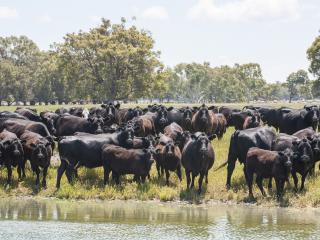Producers are encouraged to check the water quality of dams following recent heavy rainfall in the southern part of the state.
Department of Agriculture and Food research officer John Paul Collins said the rainfall had created high runoff, which may have washed a large amount of organic material into dams causing blue-green algal blooms.
“Livestock can be poisoned by drinking water where algal blooms have released toxins into the water,” Mr Collins said.
“Symptoms of poisoning in livestock include difficulty breathing, muscular weakness and signs of paralysis or nervous twitching. Stock may lapse into a coma before dying quietly near the affected water source.”
If producers suspect poisoning from blue-green algae, livestock should be isolated from the contaminated water and water samples should be taken and sent to the department’s Animal Health Laboratory in South Perth for testing.
Mr Collins said water could still be toxic to stock even after a bloom has disappeared.
“Stock should not be allowed to access affected water for at least 10 days after the bloom has disappeared,” he said.
“Treatment of blue-green algal blooms includes chemical options such as simazine, cupricide and copper sulphate.
“However, producers need to be aware that cupricide and copper sulphate can kill crustaceans and can cause corrosion of pumps.”
Mr Collins said producers should also consider skimming organic material from the dam water surface before it sinks and removing the sludge from the edge of the dam.
“Another option to consider is to de-silt and flush out their dam to ensure the problem does not reoccur,” he said.
More information on sampling and treating contaminated water is available from the department’s Contamination of farm dams webpage found at agric.wa.gov.au
Information of rates for chemical options can be found on the department’s Toxic algal blooms webpage.
Producers are encouraged to check the water quality of dams following recent heavy rainfall in the southern part of the state.
Department of Agriculture and Food research officer John Paul Collins said the rainfall had created high runoff, which may have washed a large amount of organic material into dams causing blue-green algal blooms.
“Livestock can be poisoned by drinking water where algal blooms have released toxins into the water,” Mr Collins said.
“Symptoms of poisoning in livestock include difficulty breathing, muscular weakness and signs of paralysis or nervous twitching. Stock may lapse into a coma before dying quietly near the affected water source.”
If producers suspect poisoning from blue-green algae, livestock should be isolated from the contaminated water and water samples should be taken and sent to the department’s Animal Health Laboratory in South Perth for testing.
Mr Collins said water could still be toxic to stock even after a bloom has disappeared.
“Stock should not be allowed to access affected water for at least 10 days after the bloom has disappeared,” he said.
“Treatment of blue-green algal blooms includes chemical options such as simazine, cupricide and copper sulphate.
“However, producers need to be aware that cupricide and copper sulphate can kill crustaceans and can cause corrosion of pumps.”
Mr Collins said producers should also consider skimming organic material from the dam water surface before it sinks and removing the sludge from the edge of the dam.
“Another option to consider is to de-silt and flush out their dam to ensure the problem does not reoccur,” he said.
More information on sampling and treating contaminated water is available from the department’s Contamination of farm dams webpage.
Information of rates for chemical options can be found on the department’s Toxic algal blooms webpage.

Media contacts: Jodie Thomson/Katrina Bowers, media liaison, +61 (0)8 9368 3937
